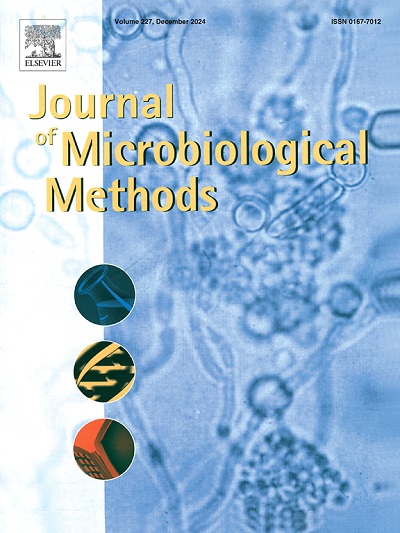抗菌药耐药性分子检测方法的一致性:对污水厂进水的横断面研究。
IF 1.9
4区 生物学
Q4 BIOCHEMICAL RESEARCH METHODS
引用次数: 0
摘要
用于鉴定废水中微生物组和抗菌药耐药性基因(ARGs)的方法尚未标准化。我们使用枪式元基因组测序(SM-Seq)、RNA 测序(RNA-seq)和靶向 qPCR 比较了澳大利亚一家市政污水处理厂进水中的微生物和 ARG 的多样性。利用 CARD-RGI 和 MEGARes 数据库对 ARGs 进行了注释,并通过 16S rRNA 基因测序和 SM-Seq 对细菌多样性进行了表征,同时分别利用 SILVA/GreenGenes 数据库或 Kraken2 和 NCBI 核苷酸数据库对物种进行了注释。CARD 和 MEGARes 发现的 ARG 分布均匀,但 MEGARes 发现的 ARG 更丰富(丰富度 = 475 对 320)。从质量上看,在所有检查过的数据库中,编码氨基糖苷类、大环内酯-林可酰胺-链霉亲和多药耐药性的 ARGs 数量最多。RNA-seq 仅检测到 32% 由 SM-Seq 鉴定出的 ARGs,但 SM-Seq 和 RNA-seq 对氨基糖苷类、大环内酯-林可酰胺类、苯酚类、磺胺类和多种药物耐药性的定性鉴定结果一致。qPCR 证实检测到了一些由 SM-Seq 和 RNA-seq 在进水中鉴定出的 ARGs,包括 OXA、VEB 和 EREB。对于细菌而言,SM-Seq 或 16S rRNA 基因测序在进行门类或类别水平的种群分析方面同样有效。不过,SM-Seq 发现的物种丰富度明显更高(丰富度 = 15,000 对 3750)。这些结果表明,SM-Seq 与 CARD 和 MEGARes 中的基因注释同样适用于监测废水中的抗菌药耐药性。然而,对于更精确的 ARG 识别和定量,MEGARes 的分辨率更高。检测到的 ARGs 的功能尚未得到确认,但 RNA-Seq 和 SM-Seq 在按抗菌素类别划分的假定表型耐药性概况方面基本一致。本文章由计算机程序翻译,如有差异,请以英文原文为准。
Concordance in molecular methods for detection of antimicrobial resistance: A cross sectional study of the influent to a wastewater plant
Methods that are used to characterise microbiomes and antimicrobial resistance genes (ARGs) in wastewater are not standardised. We used shotgun metagenomic sequencing (SM-Seq), RNA sequencing (RNA-seq) and targeted qPCR to compare microbial and ARG diversity in the influent to a municipal wastewater treatment plant in Australia. ARGs were annotated with CARD-RGI and MEGARes databases, and bacterial diversity was characterised by 16S rRNA gene sequencing and SM-Seq, with species annotation in SILVA/GreenGenes databases or Kraken2 and the NCBI nucleotide database respectively. CARD and MEGARes identified evenly distributed ARG profiles but MEGARes detected a richer array of ARGs (richness = 475 vs 320). Qualitatively, ARGs encoding for aminoglycoside, macrolide-lincosamide-streptogramin and multidrug resistance were the most abundant in all examined databases. RNA-seq detected only 32 % of ARGs identified by SM-Seq, but there was concordance in the qualitative identification of aminoglycoside, macrolide-lincosamide, phenicol, sulfonamide and multidrug resistance by SM-Seq and RNA-seq. qPCR confirmed the detection of some ARGs, including OXA, VEB and EREB, that were identified by SM-Seq and RNA-seq in the influent. For bacteria, SM-Seq or 16S rRNA gene sequencing were equally effective in population profiling at phyla or class level. However, SM-Seq identified a significantly higher species richness (richness = 15,000 vs 3750). These results demonstrate that SM-Seq with gene annotation in CARD and MEGARes are equally sufficient for surveillance of antimicrobial resistance in wastewater. For more precise ARG identification and quantification however, MEGARes presented a better resolution. The functionality of detected ARGs was not confirmed, but general agreement on the putative phenotypic resistance profile by antimicrobial class was observed between RNA-Seq and SM-Seq.
求助全文
通过发布文献求助,成功后即可免费获取论文全文。
去求助
来源期刊

Journal of microbiological methods
生物-生化研究方法
CiteScore
4.30
自引率
4.50%
发文量
151
审稿时长
29 days
期刊介绍:
The Journal of Microbiological Methods publishes scholarly and original articles, notes and review articles. These articles must include novel and/or state-of-the-art methods, or significant improvements to existing methods. Novel and innovative applications of current methods that are validated and useful will also be published. JMM strives for scholarship, innovation and excellence. This demands scientific rigour, the best available methods and technologies, correctly replicated experiments/tests, the inclusion of proper controls, calibrations, and the correct statistical analysis. The presentation of the data must support the interpretation of the method/approach.
All aspects of microbiology are covered, except virology. These include agricultural microbiology, applied and environmental microbiology, bioassays, bioinformatics, biotechnology, biochemical microbiology, clinical microbiology, diagnostics, food monitoring and quality control microbiology, microbial genetics and genomics, geomicrobiology, microbiome methods regardless of habitat, high through-put sequencing methods and analysis, microbial pathogenesis and host responses, metabolomics, metagenomics, metaproteomics, microbial ecology and diversity, microbial physiology, microbial ultra-structure, microscopic and imaging methods, molecular microbiology, mycology, novel mathematical microbiology and modelling, parasitology, plant-microbe interactions, protein markers/profiles, proteomics, pyrosequencing, public health microbiology, radioisotopes applied to microbiology, robotics applied to microbiological methods,rumen microbiology, microbiological methods for space missions and extreme environments, sampling methods and samplers, soil and sediment microbiology, transcriptomics, veterinary microbiology, sero-diagnostics and typing/identification.
 求助内容:
求助内容: 应助结果提醒方式:
应助结果提醒方式:


